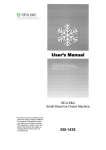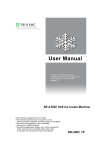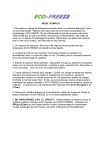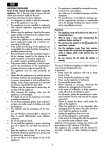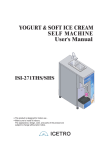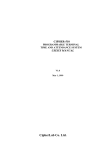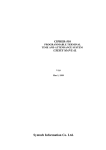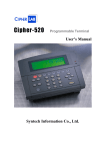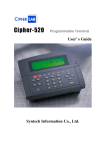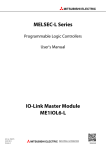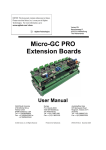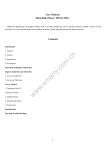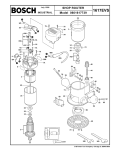Download User Manual
Transcript
User Manual Read this manual carefully before using the product. Keep the manual in a safe place after reading it. Soft Ice Cream Machine * It cannot be used in a foreign country where the supply voltage is different. * This product is designed for indoor use. Make sure to install it indoors. * The appearance, design, color, and parts of the product are subject to change without notice under our manufacturing. SSI-203S CONTENTS Chapter 1 Safety Precautions.............................................................................. 1 Chapter 2 Installation........................................................................................... 7 Chapter 3 Functions ............................................................................................ 8 Chapter 4 Assembly and Cleaning .................................................................... 13 Chapter 5 Important Machine Management Checklist ...................................... 20 Chapter 6 Troubleshooting Guidelines .............................................................. 21 Chapter 7 Component Replacement Cycle ....................................................... 23 Chapter 8 Machine Specifications ..................................................................... 24 Chapter 9 Refrigerant Circuit............................................................................. 25 Chapter 10 Circuit Diagram ................................................................................. 26 Chapter 11 Part List ............................................................................................ 28 V1.1 Chapter 1 Safety Precautions purchased the machine, the Company’s aftersales service center, or the Company’s consumer counseling center. ② Do not let any unskilled person operate this machine. Failure to follow this instruction is dangerous and may result in a severe finger or hand injury due to moving parts. ③ Unless all of the service panels and attached doors are firmly secured by fasteners (screws), do not operate the freezer. Failure to follow this instruction is dangerous and may result in severe injury from moving parts. ④ Do not block the air inlet or outlet. Air space of at least over 16cm is required in front of both sides of the machine, as well as the back. Also, air space of 11cm is needed on the floor. Failure to follow this instruction may result in a drop in the performance of or damage to the machine. ⑤ Do not put any foreign substance or your hand into the ice cream outlet. Failure to follow this instruction is dangerous and may result in contamination of the machine or an injury from moving parts. Do not take apart doors, the dasher and its blades, the drive shaft, the air pump, or the mix pump unless all the control switches are in the OFF position. Failure to follow this instruction is dangerous and may result in an injury from moving parts. ⑥ Be careful when taking apart the dasher assembly. Otherwise there is a danger of suffering an injury from sharp mixing blades (LUG POM). ⑦ Size of Noise: Noise must not exceed 78dB(A) when measured at a distance of 1.0 meter from the machine and at a height of 1.6 meters from the floor. The Company would like to ensure the safety of the user or service technician who comes into contact with the ice cream maker or its components. For example, safety precaution labels have been attached to relevant parts of the machine as advance warnings for the user or service technician. “Important Point – Failure to observe any of the following safety precautions may result in severe personal injury. Failure to observe any warning may result in damage to the machine or its components. If any component is damaged, it may cause you to incur some replacement or repair expenses. Please be careful.” Safe Operation: You must not operate the ice cream maker before reading this user manual. Failure to follow the instructions in this manual may result in damage to the equipment, improper performance, or personal health risk, injury or death. The Company will not be liable for any accident attributable to the user’s failure to follow instructions. ① ever operate the freezer without proper electrical grounding. Failure to follow this instruction may result in death due to electric shock. Unless the machine is electrically grounded, there is a danger of electric shock, which may result in death. Never do any repair work before turning off the main power supply of the machine. Failure to follow this instruction may result in an electric shock. For more detailed information on using the ice cream maker safely or any other information, please contact and consult the Company’s sales agent from whom you have 1 V1.1 CAUTION and WARNING Signs for Safety The caution and warning signs for safety are intended to help the user use the machine properly and therefore prevent accidents or dangers. Please understand the following and be sure to observe them. Description of Signs Sign Meaning WARNING Means that improper use may result in serious injury or AVERTISSEMENT death. CAUTION Means that improper use may result in personal injury or ATTENTION material damage. ※ “Personal injury” referred to above means any injury or burn that does not require receiving regular hospital treatment as an outpatient for an extended period of time. ※ “Material damage” referred to above means damage to property, such as a house or furniture. ※ “Caution and warning labels” are attached to the main body of the machine. If labels are contaminated or unclear, please contact the Company sales agent from whom you purchased the machine or the Company’s after-sales service center. Description of Symbols Symbol Meaning Indicates prohibition (i.e. must NEVER do ). Each specific prohibition is described by a picture or sentence inside the symbol. Indicates compulsory actions (i.e. MUST DO without fail). Each specific compulsory action is described by a picture or sentence inside the symbol. Indicates a caution or warning. Each specific caution or warning is described by a picture or sentence inside the symbol. 2 V1.1 WARNING / AVERTISSEMENT Have a specialist company install or move the machine. If the machine is not installed properly, there is a danger of accidents such as falling, etc. Installation work must be performed in accordance with the relevant laws such as the Korean Standards, the Road Traffic Act, the Fire Services Act, the Food Sanitation Act, etc. Improper installation may result in accidents. * Please contact the Company sales agent from whom you purchased the machine. If the electrical outlet you are using is not equipped with a grounding terminal, be sure to ground the machine properly. Unless the machine has been properly grounded, electricity leaks may cause an electric shock. Do not connect the ground wire to a gas or water pipe because there is a danger of explosion or electric shock. Observe the laws. Ground the machine. Be sure to plug the machine into a proper voltage outlet equipped with a grounding terminal (power voltage: AC220V±10%, electrical outlet: 50A or over) Do not extend the length of the power supply cord or allow it to be twisted, this may cause a fire or electric shock. Do not take apart and remodel the machine. It may cause a fire, electric shock, or personal injury. power voltage : AC220V±10%, electrical outlet : 50A or over Prohibition Have a specialist company repair the machine. Imperfect repairs may cause a fire, electric shock, or personal injury. * If you think the machine is out of order, contact the Company’s after-sales service center. Always keep the caution and warning labels clean enough to be easily readable. If important caution or warning contents are unreadable, there is a great possibility of improper use, which may result in accidents. Check the caution and warning labels. Entrust any repair work to the service center. Do not put any heat source near the power supply cord. This may cause the covering of the power supply cord to melt, thus resulting in a fire or electric shock. Do not put any object on the power supply cord. Do not let it get twisted or tied. This may cause a fire or electric shock. No! Prohibition Prohibition Do not put any heat source near the power supply cord. This may cause the covering of the power supply cord to melt, thus resulting in a fire or electric shock. Do not put any object on the power supply cord. Do not let it get twisted or tied. This may cause a fire or electric shock. Prohibition Prohibition 3 V1.1 WARNING / AVERTISSEMENT Do not put any combustible gas or flammable substance (such as benzene, gasoline, thinner, and LP gas) inside or near the machine. This may cause an explosion, fire, or personal injury. Put into the machine only the products specified in the usage instructions or on the name plate. Putting in any unspecified product may cause the machine to break down. Put in only the specified product. Prohibition Do not use any combustible gas or flammable substance (such as benzene, gasoline, thinner, and LP gas) near the machine. This may cause an explosion, fire, or personal injury. Do not touch the operation section. Do not touch the operating components inside the machine. It can result in injury. No touch! Prohibition Do not touch any electrical component with a wet hand. If there is a strange sound, smell, or smoke coming out of the machine, remove the power supply plug from the outlet. Continuing to use it in such a case may cause a fire or electric shock. This may cause an electric shock. ROLLING Prohibition Pull out the plug. Do not put any object on the machine. This may cause the machine to overturn or the object to fall. Do not sit on the machine. Do not shake or tilt it. This may cause the machine to overturn or to break down. Prohibition Prohibition Beware of the metal corners and the ventilation grooves of the machine. Do not touch the metal corners and the ventilation grooves. 4 V1.1 WARNING / AVERTISSEMENT When replenishing the mix, be careful to prevent rain or snow from coming into contact with any electrical component inside the machine. This may cause abnormal operation. Do not touch the high-temperature section inside the machine. Although there is a caution label attached to the high-temperature section, contact with it may cause burns or an unexpected injury. Do not touch! Be careful to prevent water from coming into contact with internal components of the machine or any electrical component. In cases where the machine has been submerged by a flood, water or other liquid, call and request for an inspection by the Company’s after-sales service center. It may cause electrical leakage, thus resulting in a fire or electric shock. In case of not using the machine for a long time, be sure to clean it after pulling out the power supply plug from the electrical outlet. If the machine is not kept clean while not in use, mix may go bad and/or colon bacilli may proliferate. When removing the power supply plug from the electrical outlet, pull it out by grasping the plug head. Pulling the plug out by grasping the cord may damage it, thus resulting in a fire or electric shock. When disposing of the machine, entrust it to a disposal specialist company. Leaving it to stand idle and neglected may cause accidents. ※ Contact the Company’s sales agent from whom you purchased the machine. Clean the area between both terminals of the power supply plug and its contact surface to be free of foreign substances. Foreign substances may cause poor electrical conduction, thus resulting in a fire. In case of selling or transferring the machine to someone else, be sure to hand over the user manual as well. It is impossible to use the machine properly without the user manual and improper use may cause accidents. User Manual 5 V1.1 CAUTION / ATTENTION In case of cleaning the condenser, be sure to wear protective gloves. There is a danger of a hand injury from sharp metal edges. (※ In the case of the condenser with a cooling device) In case of cleaning the inside of the machine, wear rubber gloves. Cleaning without wearing rubber gloves may result in an electric shock or injury. Wear gloves. In case of replacing or repairing the power supply cord, entrust it to a specialist company or the Company’s after-sales service center. Remove the stagnating water from the water trap at regular intervals. If stagnating water decays the machine or overflows its bottom, it may cause a fire or electric shock. SERVICE CENTER 6 V1.1 Chapter 2 Installation Cooling System The cooling system requires free space of at least over 20 centimeters in front of each side of the machine for the sake of proper air-flow. A lack of proper free space may decrease the cooling performance of the freezer and/or cause permanent damage to the compressor. Electrical Connection Each freezer requires the supply of electrical power. Please check the fuse, current, and electrical specifications. Refer to the connection diagram at the back of the machine. CAUTION / ATTENTION : This system requires proper grounding. Otherwise, there is a danger of severe personal injury due to electric shock. The rotation of the dasher must be clockwise. CAUTION / ATTENTION : The following must be performed by a trained A/S technician: Change the lead wire in the dasher motor to ensure the correct rotation of the single-phase power supply. (Follow the connection diagram printed on the motor.) The electrical connection is designed to be directly linked with the main control box inside the panel next to the upper left part of the machine. 7 V1.1 Chapter 3 Functions CAUTION / ATTENTION : An audible alarm sounds whenever a button is pressed. To cancel any function, press the function button again. The lamp will turn off. Power Switch When placed in the ON position, the power switch activates the front operation panel. “MIX LOW and MIX OUT” Lamp The MIX LOW lamp is located above the green color FND. If “MIX LOW” lamp is lighting, the supply level of mix in the storage container is too low. In such a case, the mix storage container must be replenished as soon as possible. The quantity level of mix in the storage container must be maintained at 8cm or higher at all times. If the amount of mix is below this minimum level, it may freeze up, which consequently may result in damage to the dasher, its blades, the drive shaft, and/or the outlet. If “MIX OUT” lamp is lighting, this machine is stop. “MIX” Button When this button is pressed, the lamp will indicate that the machine has begun operating in the Mix Refrigeration mode. This function cannot be canceled unless the AUTO or STANDBY mode is canceled in advance. “STAND BY” Button The machine has a separate refrigeration system in order to prevent the spread of bacteria while the mix is in the hopper at 5°C or less. This function is designed to prevent the mix in the freezing cylinder from getting excessively cold and to keep it consistently refrigerated in storage at about 0°C to 5°C when the machine is not in use for a long time. In this case, after pressing this key, remove the upper air orifice, reverse the carburetor so that the end without a hole faces downward. Pressing this button turns on the lamp and activates this function. During the Standby mode, the WASH and AUTO functions are in the OFF position. To resume normal operation, press the AUTO button. When the machine stops rotating, the products in the freezing cylinder are probably very sticky. In this case, reverse the carburetor so that the end with a hole faces downward in order to let air flow inside and then install the upper air orifice. 8 V1.1 “WASH” Button Pressing this button turns on the lamp. It means that the dasher motor starts operating. In order to make the machine operate in WASH mode, the STANDBY button and/or the AUTO button must be canceled in advance. “AUTO” Button Pressing this button turns on the lamp. This means that the machine starts operating in the Main Refrigeration mode. During the AUTO mode, the WASH and STANDBY functions are automatically canceled. The MIX function is automatically controlled so that the quantity of mix may be maintained in the storage container. “SELECT” Button Pressing this button turns on the lamp. The temperature of mix hopper and cylinder, ambient are indicated on the green color FND. 2-1 : Mix hopper sensing temperature 2-2 : Cylinder sensing temperature 2-3 : Surrounding sensing temperature The above items and temperature are indicated at 2 second intervals, and the next item is indicated when “SELECT” button is pressed. If the operation of button is not done for 30 seconds, the level of ice-cream on “AUTO” mode is indicated, on “STAND BY” mode the temperature of cylinder is indicated, on “MIX” mode the temperature of mix hopper is indicated. “SET” Button Pressing this button turns on the lamp. This button indicated the status of setting conditions. 1-1 : Ice-cream setting current 1-2 : No-load motor current 1-3 : Input voltage 1-4 : Mix hopper setting temperature 1-5 : Voice service 1-6 : Program version Above items are indicated on the red color FND, when the “SET” button is pressed. If you check the setting value, press “▼” or “▲” button. If the operation of button for 30 seconds is not done, indicated the value of motor current now. And the user can change the hardness of ice-cream, the temperature of mix hopper and the select of voice service. If “SET” button is pressed for 3 seconds, the setting conditions can be changed when the password is entered. (Initial password is 0, 0, 0, 0) 3-1 : Change the ice-cream setting current 3-4 : Change mix hopper setting temperature 3-5 : Select the voice service The secret code can be selected by “▼” or “▲” button. After that press “SET” button. If the user want to change the password, enter the new password after the now secret code when the 3 button of “▼”, “▲”, “SET“ are pressed for 5 seconds at a time. If you have lost the password, turn on dip switch No. 1 of 1 in the display PCB, and energize the PCB to reset the password to the initial value "0, 0, 0, 0". it is not possible to change the setting conditions. So keep it mind. 9 V1.1 Indicate Input Voltage The voltage levels in item 4-13 (100V,110V,115V,120V,200V,210V,220V,230V,240V) can be selected. If the input voltage exceeds the selected value by ±10% or more, the voltage value will flash in the red FND and a buzzer will sound for 1 second. If the voltage deviation exceeds ±15%, the product's power will be turned off. (Make sure to set the automatic no-load function if the reference voltage is changed.) Button lock function After entering the "AUTO", "STANDBY", or "MIX" mode, press the ▲ and ▼ buttons for 5 seconds. The buttons will be locked with a 'ding' sound. The same procedure applies for lock release. Automatic no-load setting When the power is turned on again after turning it off, if the temperature of the cylinder containing the raw material is 5℃ or above, this function is automatically applied after sensing for 10 seconds when entering the AUTO mode. (Do not change the reference voltage after automatic no-load setting.) Error Code Guide If an error occurs, the error code will appear on the set FND. Er01 : refrigerator temperature sensor wire open Er02 : refrigerator temperature sensor wire short Er03 : freezer temperature sensor wire open Er04 : freezer temperature sensor wire short Er05 : ambient temperature sensor wire open Er06 : ambient temperature sensor wire short Er07 : motor over current detected When the motor current cannot be detected while the motor is running (operation stopped). Motor failure, motor wire harness or connector failure, motor wire bad in the PCB, CT in PCB failure, EOCR triggered. Er08 : high pressure detected No power supplied to the OL terminal (operation stopped). HPS bad, HPS wire harness or connector bad, OL terminal bad in the PCB, condenser clogged, fan motor failure. Er09 : no-load detected When the compressor is operating in the AUTO mode, a no-load current of +0.5A or less is detected for 20 minutes (operation stopped) Refrigerant leak, condenser clogged, inappropriate Level adjustment, unstable supply voltage. Er10 : low voltage detected Below the rated voltage by -15% or more (operation stopped). Er11 : high voltage detected Exceeds the rated voltage by +15% or more (operation stopped). Er12 : abnormal discharge detected When the DRAW S/W detects the ON signal for 15 seconds in the AUTO mode. Discharge lever failure to return, DRAW S/W failure Er13 : reverse flow detected In the AUTO mode, the DRAW S/W is OFF and fails to reach the setting value within 40 minutes, or ambient temperature of 45℃ or higher is detected for 5 minutes. Bad installation environment (vent air back-flow), refrigerant leak, condenser clogged, inappropriate Level adjustment, unstable supply voltage. Er14 : abnormal power drive detected. After reaching the setting value in the AUTO mode, with the DRAW S/W off, and a no- 10 V1.1 load current of +0.2A or less is detected for 30 seconds when the compressor is running. Belt slip, Belt cut-off, damaged power train, ice in the drum. Er15 : EEPROM error detected Er16 : Communication error Communication failure between the main PCB and the display PCB. Technician Guide Press the SET and SELECT buttons for 3 seconds simultaneously to go to the password entry step (available when there is material in the storage container). The FNDs will flash from the first to the last one. Enter 0~9 with the “▼” or “▲” buttons and press the SET button (Initial password is 1, 1, 1, 1) 4-1 : adjust motor stop time in the AUTO mode 4-2 : adjust cylinder ON temperature in the AUTO mode 4-3 : adjust storage ON/OFF temperature deviation 4-4 : adjust cylinder OFF temperature setting in the STANDBY mode 4-5 : adjust ON/OFF temperature deviation in the STANDBY mode 4-6 : adjust motor stop time in the STANDBY mode 4-7 : adjust the calculated value of the ice cream level 4-8 : set the upper limit for max. load 4-9 : set the time limit for sterilization 4-10 : select Celsius or Fahrenheit 4-11 : activate ambient temperature sensing 4-13 : set the reference input voltage 4-14 : button sensitivity setting 4-15 : select language (Korean, English) 4-16 : enter the current correction value 4-17 : select the air pump function 4-18 : select the heating (sterilization) function 4-19 : select the button lock function 4-20 : set the current correction value according to voltage change 4-21 : set the dasher motor stop delay time 4-22 : set the compressor stop delay time 4-23 : set the running time of the compressor only 4-24 : set the temperature sensing time during stop (not available when 4-23 is OFF) 4-25 : set the temperature reference sensed during 4-24 time (not available when 4-23 is OFF) 4-26 : select compensation control by the ambient temperature of the storage container 11 V1.1 “Air Tube” – CARBURETOR TUBE The air tube is supplied for two purposes. There is a hole at the one end of the tube, but there is no hole at the other end. After replenishing the mix, lubricate the O-ring placed at the end with a hole, and then insert the “CARBURETOR ADJUST” into the “CARBURETOR TUBE”, and then insert the hole on the mix container. Whenever ice cream is sold, the pull handle is raised and new mix from the mix container flows into the freezing cylinder together with air. Place the small hole of “CARBURETOR ADJUST” to “CARBURETOR TUBE” to increase the air contents. But the dispensing time is delayed be cause the mix is feed slowly. If the big hole of “CARBURETOR ADJUST” to “CARBURETOR TUBE” is placed, the dispensing time is fast. On “STAND BY” mode, place the end without the hole of “CARBURETOR ADJUST” to “CARBURETOR TUBE”. Then the mix is maintained in the status of refrigeration. O-RING SALE INCREASE DECREASE Adjustment of the Pull Handle The pull handle must be adjusted so that a cup of ice cream may come out every 10 seconds. To increase the amount of ice cream, turn the screw counterclockwise. To decrease it, turn the screw clockwise. When washing the machine, always press the handle downward and then remove the mix. 12 V1.1 Chapter 4 Assembly and Cleaning In principle, start the machine when it is fully dry. After operation, it needs to be taken apart, washed and kept dry after that. These operation procedure instructions provide an understanding of how to assemble the freezer and clean its components. Be sure to use fresh mix materials. ① Apply edible grease (lube) to the shaft. ② Fit Javara packing (flexible packing) in the groove at the end and apply lube. ③ Apply lube inside the flexible packing and the shaft. Do not apply it to the flat part of its end. ④ Insert the shaft into the internal bearing portion. The shaft should be inserted firmly into the end to prevent it from shaking. (○) (×) ⑤ When fitting the flexible packing, keep its projecting part outside. ⑥ Fit the plastic blades into the dasher. Once dasher blades have worn, the performance of the machine decreases. Replace them after three months. 13 V1.1 ⑦ The dasher blades should be inserted towards inside the cylinder to be fitted with the shaft. They must be inserted correctly and the dasher must not come out. ⑧ Try to turn the dasher blades by hand. If they don’t turn, they are in the right position to fit the internal grooves well. ⑨ Fit the gasket and the white bearing into the dasher cover. When fitting the bearing, insert it by keeping its wider part facing towards the dasher cover. Do not apply grease. ⑩ Fit the dasher cover into the machine and then insert four hand screws. Tighten them in a diagonal order but not too hard. ⑪ Apply lube to the packing to be fitted inside the shaft. Replace it if it has been damaged. 14 V1.1 ⑫ Apply edible grease into the hole of the dasher cover also, and insert the shaft downward. ⑬ Mount the draining water trap and its cover in position. ⑭ Fit the hand into the shaft and join the shaft to the machine by inserting it sideways. ⑮ Mount the side and back drain openings in position. 15 V1.1 Cleaning Step 1 Prepare 7.6 liters of wash solution. (For example, a detergent, etc.) Use warm water and follow manufacture’s specifications. Step 2 Pour 7.6 liters of wash solution into both hoppers to make it flow into the freezing cylinder. Step 3 Clean the mix container using a brush while the wash solution is flowing into the freezing cylinder. When cleaning the mix container, be particularly careful about brushing the hole of the container, the carburetor, the gasket, and the mix quantity level sensing rod on the front wall of the container. Step 4 Put the power switch in the ON position. Step 5 Press “WASH”. Then the wash solution will be stirred in the freezing cylinder. Keep it stirring for about 5 minutes. Step 6 Empty the wash solution by pulling the handle downward. 16 V1.1 Step 7 Lift the handle upward, press the WASH button and the dasher motor will stop operating. Step 8 Fix the gasket of the mix container to the rim of the top part of the container. Insert the air carburetor into the hole of the raw material container. Replenishment of Mix Step 1 Place the container under the dasher assembly and then open the handle. Pour 7.6 liters of fresh mix into the mix container to allow it to flow into the freezing cylinder. At this time, you can force the remaining wash solution to come out. When mix is fully and powerfully flowing into the dasher outlet, discharge wash solution by pressing the draw handle. Caution: Be sure to use fresh mix when replenishing it. Step 2 When mix begins to flow stably, lift the draw handle upward. 17 V1.1 Step 3 Apply grease so that the O-ring can slide over the air carburetor to fit onto the end with a small hole. Step 4 Insert the air carburetor into the mix inlet hole on the mix container and fit the air orifice into the end without a hole. Step 5 Press the AUTO button. The AUTO lamp indicates that main freezing and refrigeration functions are in operation. When the machine stops rotating, the product now has suitable viscosity for sale. If the MIX REF lamp comes on, it means that mix in the mix container is kept in the refrigeration mode. Step 6 Fill the mix container with mix. When the quantity level of mix reaches the mix quantity level sensing rod, the MIX LOW lamp will turn off. Step 7 Put the mix container lid on the mix container. Rinse Step 1 Pour 2 gallons (7.6 liters) of cold, clean water into the mix container. Clean the mix container, the mix container hole and the sensing rod by scrubbing them with a brush. Step 2 Place the container under the dasher assembly, pull the lever and then press the WASH button. Step 3 When rinse water flows stably into the opening of the dasher assembly, pull the handle down. When rinse water is discharged from the freezing cylinder, pull the handle and then stop the machine by pressing the WASH button. Disassembly and Cleaning Step 1 Make sure that the power switch is in the OFF position. Make sure also that the indication and operation lamps on the control panel have been turned off. Step 2 Remove the bolts, the dasher assembly, the dasher, the dasher blades, and the drive shaft from the freezer cylinder. Dip these components in wash solution for cleaning. Step 3 Remove the front-side water trap and the dreg lid. 18 V1.1 Cleaning with a Brush Step 1 Use warm water or wash solution. Step 2 Remove the flexible packing from the drive shaft. Step 3 Remove the following components from the dasher assembly. • Gasket • Front bearing • Handle • Design cap • Piston Remove O-rings. Caution: When removing an O-ring, take it out by grasping it with a new towel. Apply upward force until the O-ring bounces out of the groove. Push its upper part down with the other hand. The O-ring will then come out of the groove for easy removal. When removing more than one Oring, always remove the rear one first. By doing so, you can make each rear O-ring to come out by sliding over the O-rings ahead of them without falling into otherwise empty grooves. Step 4 Remove O-rings from the air carburetor and the air orifice. Step 5 Inject a very small amount of wash solution into the freezing cylinder. Clean the rear bearing of the freezing cylinder by scrubbing it with a cleaning brush. Step 6 Remove the water trap and clean it. Caution: If there is too much mix in the water trap, empty it first before cleaning. Step 7 Clean all the disassembled components thoroughly with wash solution and make sure that grease and mix have been completely removed. Pay special attention when cleaning the dasher assembly. Lay all the cleaned components on a clean place and wipe them with dry cloth or wait until they are fully dry. Step 8 Clean all external surfaces of the machine thoroughly. 19 V1.1 Chapter 5 Important Machine Management Checklist “We recommend daily washing and sterilization.” Sterilization 1. Clean the machine thoroughly at regular intervals through complete disassembly and use of a brush to keep it always sterile. 2. Use only very clean brushes. 3. Clean the mix inlet hole with a cleaning brush by extending it from the lower part of the mix container up to the rear of the freezing cylinder. 4. Clean the bearing portion behind the freezing cylinder also with a cleaning brush. 5. Keep the remaining mix in the container in the mix refrigeration mode and use it again later. 6. Use a reasonable amount of wash solution. Read and follow the operational procedure and cleaning method instructions carefully. 7. Keep the mix container at 40°F (4.4°C) or below. Regular Maintenance Checkpoints 1. Replace any scratched or damaged blade. Before assembling and installing the dasher, make sure the blades are properly attached in a helical curve. 2. Check for any trace of wear on the bearings. (Check the rear water trap for excessive mix leakage.) Also check to make sure the bearing has been cleaned properly. 3. Remove any oil and mix dreg from the bearing and the hexagonal drive socket with a screwdriver and a towel 4. Replace any worn, torn or loose O-rings or seals with new ones. 5. For grease application, follow the “assembly” procedure. 6. In the case of an air-cooled machine, check the condenser to see if there is any dust or grime on it. A dirty condenser decreases the cooling efficiency and performance of the machine. Clean the condenser with a soft brush at least once a month. Warning: Always be sure to turn the power off before cleaning the condenser. 7. Check the condenser for refrigeration to see if there is any dust or grime on it. A dirty condenser decreases the refrigeration capacity of the mix container. It is necessary to clean the condenser with a soft brush at regular intervals in order to prevent dust from building up on it. Do not clean between fins with a screwdriver or any other sharp-ended metal. Warning: Always be sure to turn the power off before cleaning the condenser. Storage during a Long Non-Use Period In case of non-use for a long time, the following preventive measures are very important for the protection of the ice cream maker, especially if the machine has been installed in a building that has freezing problems. 1. To prevent any electrical damage, pull the power plug out of the electrical outlet. 2. Remove and pack detachable components from the ice cream machine such as the dasher, its blades, the drive shaft and the like. 3. Protect rubber components and the gasket by packing them in desiccant paper. 4. Thoroughly remove from all parts and components any dried mix or grease that may attract mice and other pests. 5. Carry out the above-mentioned faithfully to maintain the ice cream maker in good operating condition. 20 V1.1 Chapter 6 Troubleshooting Guidelines Symptoms of Problem 1 2 3 4 5 6 7 Expected Causes Resolutions ① Voltage deviates by ±15% or more. ① Supply the power in stable status. ② Initial setting before installation was ② Set the initial setting values before not performed. installation. ① The temperature sensor of the ① Check the temperature sensor of the Refrigeration Part has a problem. Refrigeration Part. Standby Lamp ① The temperature sensor of the ① Check the temperature sensor of the flickers. Refrigeration Part has a problem. Refrigeration Part. Auto Lamp flickers. ① The Temperature Sensor of the ① Check the Temperature Sensor of the Freezing Part has a problem. Freezing Part. Auto and Wash ① Ice cream is frozen too hard. ① Melt the ice cream by turning the power off Lamps flicker. (Dip S/W Setting value is too high.) and reduce the hardness of the ice cream. ② The sugar content of the ice cream ② If the sugar content of the ice cream liquid is liquid is too low. low, reduce the hardness of the ice cream. ③ Problems are caused in the Dasher ③ Inspect the inside of the Dasher and and Cylinder. Cylinder. ④ Motor does not work. ④ Inspect the Motor. ⑤ Condenser is blocked. ⑤ Remove dust from the Condenser. ⑥ Fan Motor does not work. ⑥ Inspect the Fan Motor. ⑦ High Pressure S/W has a problem. ⑦ Inspect the High Pressure S/W. ⑧ PCB has a problem. ⑧ Inspect PCB. Auto, Wash, Standby, ① Compressor does not work. ① Inspect the Compressor. and/or Mix Lamps ② Condenser is blocked. ② Remove dust from the Condenser. flicker. ③ Belt is cut. ③ Replace the Belt. ④ Coolant has leaked. ④ Request an inspection by an engineer. ① The M/C has been operated for a long ① If ice cream is not sold after formation, it time with no sale. gradually becomes thinner. ② The Blades of the Dasher are worn. ② Replace the Blades. ③ The ice cream is insufficiently hard. ③ Hardness should be adjusted to meet the All the lamps flicker. Mix Lamp flickers. Ice cream is thin. sugar content of the ice cream. ④ The ice cream production speed is too ④ Adjust the ice cream production speed to an fast. appropriate level. ⑤ Condenser has lots of dust. ⑤ Remove dust from the Condenser. 21 V1.1 8 ⑥ Coolant has leaked. ⑥ Supplement the Coolant. ⑦ Warm air flows into the condenser. ⑦ Inspect the installation environment. Ice cream is not ① The M/C is operated in the standby ① Operate the M/C in “Auto” mode. produced. and Mix mode. ② Raw Liquid has been used up. ② Supplement the Raw Liquid. The Storage Tank should contain Raw Liquid. ③ The holes of Storage Tank and/or ③ Make the Raw Liquid flow into the Cylinder. Carburetor are blocked. 9 10 11 ④ The hardness of ice cream is too high. ④ Reduce the hardness. Ice cream does not ① Compressor does not work. ① Inspect the Compressor. form. ② Motor does not work. ② Inspect the Motor. ③ Condenser is blocked. ③ Remove dust from the Condenser. ④ Warm air flows into the condenser. ④ Inspect the installation environment. ⑤ Coolant has been leaked. ⑤ Inform a service center of such leakage. Overrun is poorly ① Carburetor is not available. ① Install the Carburetor. executed. ② Large Hole of Carburetor is used. ② Use the Small Hole of the Carburetor. ③ O-Ring of Carburetor is worn or cut. ③ Replace the O-Ring of the Carburetor. The M/C operates for ① Warm air flows into the condenser. ① Inspect the installation environment. a long time. ② The hardness of the ice cream is set ② Reduce the hardness of the ice cream. too high. 12 ③ Raw materials are too old/out of date ③ Replace the raw materials. ④ The Blades of the Dasher are worn. ④ Replace the Blades. ⑤ Coolant has leaked. ⑤ Request an inspection by an engineer. Mechanical sound can ① The M/C has not been cleaned. ① Clean the M/C. be heard. ② Grease was not applied after cleaning. ② Apply grease. ③ Blades have not been inserted in the ③ Insert Blades. Dasher. 13 ④ Dasher Bearing has ot been installed. ④ Install the Dasher Bearing. Ice cream contains ① Water was not removed when inputting ① Remove water. lots of ice particles. the raw liquid. ② Raw liquid contains high level of water. ② Use the material that contains water at low level. 14 ③ The Blades of the Dasher are worn. ③ Replace the Blades. The product smells ① Old raw liquid was used. ① Replace the raw liquid. strange. ② The M/C has not been cleaned. ② Clean the M/C everyday. ③ Drain Slug has not been cleaned. ③ Clean the Drain Slug everyday. 22 V1.1 15 16 17 18 19 20 Drain Slug shows too ① Drain Slug has not been cleaned. ① Clean the M/C. much leakage. ② Packing Bellow is old or unavailable. ② Replace the Packing Bellow. Ice cream leaks to ① Bolts have not been fastened. ① Fasten the Bolts. Dasher Cover. ② Dasher Packing is old or unavailable. ② Replace the Dasher Packing. Ice cream leaks ① Sales Lever has been turned down. ① Turn the Sales Lever up. through the outlet. ② Piston Ring is worn or cut. ② Replace the Piston Ring. Sales Lever does not ① Grease was not applied to the Piston ① Apply grease to the Piston Ring. turn smoothly. Ring. ② The M/C has not been cleaned. ② Clean the Piston Ring. The raw materials are ① Refrigeration temperature is set too ① Set the refrigeration temperature somewhat frozen in the Storage low. higher. Mix the raw materials periodically. Tank. ② The temperature of the raw materials ② Use refrigerated raw materials when being supplemented is high. supplementing raw materials. The temperature of ① The temperature of the raw materials ① Mix the raw materials periodically. the raw materials in at the upper position in the Storage Tank Set the refrigeration temperature somewhat the Storage Tank is is high. lower. too high. ② The cover of Storage Tank is not ② Close the cover of the Storage Tank properly placed. properly. ③ Compressor does not work. ③ Inspect the Compressor. ④ Warm air flows into the Condenser. ④ Inspect the installation environment. ⑤ Fan Motor does not work. ⑤ Inspect the Fan Motor. 23 V1.1 Chapter 7 Component Component Replacement Cycle Every three months Flexible packing for the drive shaft O Scrapper blade O Dasher assembly gasket O Dasher assembly bearing O Piston O-ring O O-ring O Air carburetor O-ring O Air orifice O-ring O Every six months Inspection and replacement (when necessary) Inspection and replacement (when necessary) White coarse brush Black coarse brush 24 V1.1 Chapter 8 Machine Specifications Item Spec Unit Specifications Indefinite sales (one 100cc serving per 30 seconds). Based on an ambient temperature of 30°C or below, humidity of 60% or below and mix temperature 5°C or below. Selling capacity May vary depending on the ice cream maker and mixes. Production capacity kg/hr 45 x 2EA Cooling capacity ditto Can begin selling 12 minutes after cylinder tank operation. Mix reaches -6.5°C at the ambient temperature of 30°C. Cylinder capacity liter 2.0 Mixing tank capacity liter 10 x 2EA Height mm 1530 Width mm 590 Depth mm 900 V / Hz 230 / 50 / 1PH Dimensions Power supply Before Packing 250 Weight kg After Packing Compressor Cooling system 275 Freezer Refrigerator NJ2212GK GL-60TG Output HP 1.2 x 2EA 1/5 Condenser fan motor Output W 200 20 Rated power consumption KW 4.5 Temperature control MICOM-CONTROL Free service parts supplied with the machine 10 dasher blades, 4 piston rings, 2 brushes, 2 outlet rings, 2 flexible hose rings and 1 can of edible grease (Haynes) 25 V1.1 Chapter 9 Refrigerant Circuit Mix tank S Capillary Solenoid V/V Mix Sensor E.P.R Mix tank S Capillary Drier Solenoid V/V Mix Sensor Suction pipe Refrigerator Compressor Automatic Expansion Valve Automatic Expansion Valve Cylinder Sensor Condenser Fan Motor Freezer Compresor H.P S/W H.P S/W Discharge pipe Suction pipe Cylinder Sensor Filter Drier Freezer Filter Drier Suction pipe Freezer Freezer Compresor Discharge pipe Refrigerant Injection 1. Remove the left-side and rear-side covers from the machine. 2. Identify the improperly operating compressor and remove its cap. 3. Close the manifold gauge by turning its left and right handles. Close the refrigerant container valve by turning its handle. 4. Connect the central hose of the manifold gauge to the refrigerant container and tighten the connection. (Turn over the refrigerant container and fill it with liquid refrigerant.) 5. Connect the joint at the end of the low-pressure hose to the low-pressure part of the compressor and tighten the connection. Be careful not to over torque the screw threads while tightening. 6. Start the cooling unit after turning on its power supply. 7. Open the low-pressure gauge completely by turning its handle. Watch the reading of the lowpressure gauge after operating the cooling unit for at least 30 minutes and inject refrigerant while opening and closing the valve handle repeatedly so that the reading may be the same as the prescribed value. 8. After finishing refrigerant injection, fit the cap onto the compressor. * Caution: The above-mentioned refrigerant injection method is based on an ambient temperature of 32°C and humidity of 60%. The reading of the pressure gauge may vary depending on the ambient temperature. * For freezing: 950g~1100g under the noload condition, low pressure of 0~60PSIG, high pressure of 250~350PSI * For refrigeration: R-134a 180g, low pressure of 0~60PSIG * E.P.R.: 68~70PSI 26 ELB or NSF 27 3 1 * CONTRACTION COMP1 COMP2 COMP3 MOTOR1 MOTOR2 FAN1 FAN2 MC1 MC2 Ry1 Ry2 Ry3 Ry4 EOCR1 or EMR1 EOCR2 or EMPR2 HPS1 HPS2 SV1 SV2 * WIRE COLOR B BLACK BR BROWN RED R O ORANGE Y YELLOW BL BLUE V VIOLET GY GRAY W WHITE G GREEN N L R T1 L1 B MC1 L2 T2 R COMP1 MC1 W R T1 L1 B MC3 L2 T2 R COMP2 MC2 W BL T3 L3 B FAN1 MC1 W MC2 W T3 L3 Y 4 2 B COMP3 Ry3 W Left freezer compressor Right freezer compressor Both refrigerator compressor Left freezer motor Right freezer motor Freezer fan motor Refrigerator fan motor Magnetic contactor for left freezer compressor Magnetic contactor for right freezer compressor Relay for left freezer motor Relay for right freezer motor Relay for left refrigerator solenoid valve Relay for right refrigerator solenoid valve Over current relay for left freezer motor Over current relay for right freezer motor High pressure switch for left freezer compressor High pressure switch for right freezer compressor Solenoid valve for left refrigerator hopper Solenoid valve for right refrigerator hopper TERMINAL BLOCK 4 2 B FAN2 Ry4 W BR 8 6 B SV1 Ry3 W BR 8 6 B SV2 Ry4 W SSI-203S CIRCUIT DIAGRAM GY GY 4 2 B Ry1 6 8 R MOTOR1 Ry1 W 1 HPS1 BR MIX SENSOR1 EMPR1 2 CYLINDER SENSOR1 SWITCH 1 CN3 AIR SENSOR1 2 A1 A2 0 SENSOR1 S/W1 1 Ry1 DRAW 96 EMPR1 A2 Ry3 95 A1 B A2 EMPR1 V GY GY 4 2 B Ry2 6 8 R MOTOR2 Ry2 CYLINDER SENSOR2 MIX SENSOR2 EMPR2 BR HPS2 1 3 CN2 1 2 CN1 B V 1 2 CN2 4 CN11 CN10 2 4 2 A2 A1 A2 0 SENSOR2 S/W2 1 Ry2 DRAW 96 EMPR1 Ry4 95 CN3 1 3 A1 MC2 CN4 B Y B O B R AIR SENSOR2 CN7 CN4 CN5 A1 B A2 EMPR2 V CODE NO : 3800717-00 CN5 MAIN PCB2 CN1 CONTROL PCB2 Chapter 10 3 CN2 1 2 4 A1 MC1 CN4 B Y B O B R 1 CN5 MAIN PCB1 CN1 CN7 CN4 CN5 3 1 2 CN2 4 CN11 CN10 CONTROL PCB1 2 CN1 B V V1.1 Circuit Diagram V1.1 Chapter 11 Part List 1. Out side Part BRACKET MICRO S/W 301037800(2EA) GRIP HANDLE 3420019-00(2EA) MAIN SWITCH 3550085-00(1EA) MICRO S/W 3550082-00(2EA) FRONT COVER UP 3170915-00(1EA) PISTON MIDDLE 3030087-00(1EA) PISTON L, R 3030084-00(2EA) BUTTON PCB 3670059-00(2EA) BUTTON DISPLAY 4400094-00(1EA) SIDE PANEL L 3490552-00(1EA) PATITION FOOD 2320028-00(2EA) COVER FOOD PAN 3080022-00(2EA) TOP COVER 3170914-00(1EA) BUTTON FRAME 4400095-00(1EA) SHAFT POM PACKING 2320027-00(5EA) GRIP HAND 3420026-00(3EA) BOLT COVER POM 2140148-00(2EA) MAIN PCB 3670058-00(2EA) LEVER SHAFT 3140071-00(2EA) COLUMN BACK 3170929-00(R) ( 3170928-00(L) BACK PANEL 3490551-00(1EA) DASHER ASS'Y 4030072-00(2EA) DASHER BEARING 3100010-00(2EA) SIDE PANEL R ASSY 4200189-00(1EA) LEVER DASHER 3090025-00(3EA) FRONT COVER TOP ASS'Y 4320189-00(1EA) FILTER CONDENSER 6400036-00(1EA) DASHER LUG POM 6100177-00(2EA) PACKING DASHER COVER 3030075-00(2EA) DRAIN BOX UP 3360098-01(1EA) CASTER FREE BREAK DASHER COVER 3170745-00(1EA) STAR MADE 3880004-00(3EA) DASHER LEVER SHAFT 3140070-00(1EA) DRAIN BOX 3360095-01(1EA) 21800266-00(4EA) SIDE PANEL R DOWN ASS'Y 4200190-00(1EA) HANDLE GRIP ONE 3420031-00(4EA) FRONT COVER DOWN 3170930-00(1EA) 28 V1.1 2. Moving and Drum Part CABURATOR ADJUST 2340004-00(2EA) CABURATOR TUBE BODY 2340008-00(2EA) PACKING SENSOR-B 3030073-00(2EA) SHAFT TOP PULLY 3140059-00(2EA) NUT(M5) SENSOR RING 3480044-00(2EA) SENSOR POST 3480043-00(2EA) PACKING JAVARA 3030076-00(2EA) SENSOR PACKING 3030083-00(2EA) SENSOR POLE 3480045-00(2EA) BEARING DRUM 3270057-00(2EA) SET BOLT 2108035-00(4EA) RING BEARING SHAFT 2320024-00(2EA) SHAFT TOP CONECT 3140061-00(2EA) BELT PULLY TOP 3070020-00(2EA) DRUM ASSY 203 4100117-00(1EA) KEY 2190015-00(2EA) GEARED MOTOR ASS'Y 4060080-00(2EA) V-BELT HZ: 3070044-00(4EA) ( 50 60 HZ: 3050018-00(4EA) BOLT HEX B00E01060(8EA) DASHER MOTOR 60HZ : 3530178-00(2EA) STOPPER BEARING DRUM 3980091-00(2EA) ( 50HZ : 3530156-00(2EA) NUT BEARING DRUM 3270055-00(2EA) KEY 2190015-00(2EA) SPRING VIBRATION 3230024-00(4EA) BRACKET MOTOR FOOT 3010382-00(4EA) RING OIL 2320019-00(2EA) BELT PULLY DOWN HZ: 3070044-00(2EA) ( 60 50 HZ: 3070041-00(2EA) MOTOR FOOT RUBBER 3530082-00(2EA) MOTOR FRAME 3530179-00(2EA) 3. Control Box Part CONTROL BOX 3741124-00(1EA) RELAY 6020005-00(4EA) CONTROL PCB 3670060-00(2EA) MAGNET 3220038-00(2EA) TEMINAL BLOCK 3630046-00(1EA) EMPR 3560006-00(2EA) 29 V1.1 4. Cooling Part SOLENOID V/V 340066-00(2EA) FILTER DRIER 3720014-00(1EA) AXIAL FAN 3530099-00(1EA) CAPILLARY 3250003-00(2EA) EPR 5230003-00(1EA) CONDENSOR COVER 3170927-00(1EA) CONDENSER ASS'Y 4110092-00(1EA) COMPRESSOR 50, 60Hz : 3940088-00(1EA) FILTER DRIER 3720012-00(2EA) CON. OUTLET PIPE 3250564-00(L) 3250563-00(R) ( CONDENSER ASS'Y 4110093-00(1EA) CHARGE NIPPLE ASS'Y 4590004-00(2EA) HIGH PRESSURE S/W 3550077-00(2EA) DISCHARGE PIPE 4330102-00(R) ( 4330103-00(L) EXPANSION VALVE 3400081-00(2EA) SUCTION PIPE 3250565-00(R) FAN 3080031-00(1EA) FAN MOTOR 3530181-00(1EA) COMPRESSOR 60Hz : 3940091-00(2EA) ( 50Hz : 3940086-00(2EA) ANGLE BASE 30 V1.1 MEMO 31 If you need after-sales services... Any problem with the machine? Turn off the circuit breaker first of all, and then unplug the power Call a nearby SE-A E&C office. SE-A E&C We provide service quickly. Repair complete! Product Name: Date of Purchase: ---/--/---- (dd/mm/yyyy) Customer Name: If you use the Clover Service number, your service history is registered on our computer system and you can get service more efficiently. Warranty period one year Distributor Name: Head Office: 78B 3 Lot, Namdong Industrial Complex 2, 648-2, Gojan-dong, Namdong-gu Incheon, Korea Tel: +82-32-814-0693 Fax: +82-32-814-1798 Clover Service: 1588-0049 080-646-5482



































